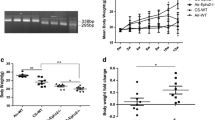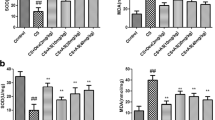Abstract
Objective and design
Gallic acid (GA) a naturally occurring phenolic compound, known to possess antioxidant/anti-inflammatory activities. The aim of the present work was to investigate the beneficial effects of GA against COPD-linked lung inflammation/emphysema by utilizing elastase (ET) and cigarette smoke (CS)-induced mice model.
Materials
Male BALB/c mice were treated with ET (1U/mouse) or exposed to CS (9 cigarettes/day for 4 days). GA administration was started 7 days (daily) prior to ET/CS exposure. Broncho-alveolar lavage was analyzed for inflammatory cells and pro-inflammatory cytokines. Lung homogenate was assessed for MPO activity/GSH/MDA/protein carbonyls. Further, Lung tissue was subjected to semi-quantitative RT-PCR, immunoblotting, and histological analysis.
Results
GA suppressed the ET-induced neutrophil infiltration, elevated MPO activity and production of pro-inflammatory cytokines (IL-6/TNF-α/IL-1β) at 24 h. Reduced inflammation was accompanied with normalization of redox balance as reflected by ROS/GSH/MDA/protein carbonyl levels. Further, GA suppressed phosphorylation of p65NF-κB and IκBα along with down-regulation of IL-1β/TNF-α/KC/MIP-2/GCSF genes. Furthermore, GA offered protection against ET-induced airspace enlargement and ameliorated MMP-2/MMP-9. Finally, GA suppressed the CS-induced influx of neutrophils and macrophages and blunted gene expression of TNF-α/MIP-2/KC.
Conclusion
Overall, our data show that GA effectively modulates pulmonary inflammation and emphysema associated with COPD pathogenesis in mice.






Similar content being viewed by others
References
Vogelmeier CF, Criner GJ, Martinez FJ, Anzueto A, Barnes PJ, Bourbeau J, et al. Global strategy for the diagnosis, management, and prevention of chronic obstructive lung disease Report. GOLD executive summary. Am J Respir Crit Care Med. 2017;195(5):557–82. https://doi.org/10.1164/rccm.201701-0218PP.
Quaderi SA, Hurst JR. The unmet global burden of COPD. Global Health Epidemiol Genomics. 2018;3:e4–e4.
Babu KS, Morjaria JB. Emerging therapeutic strategies in COPD. Drug Discov Today. 2015;20:371–9.
Kirkham PA, Barnes PJ. Oxidative stress in COPD. Chest. 2013;144:266–73.
Rahman I, Adcock IM. Oxidative stress and redox regulation of lung inflammation in COPD. Eur Respir J. 2006;28:219–42.
Rhee J-W, Lee K-W, Kim D-B, Lee Y-H, Jeon O-H, Kwon H-J, et al. NF-B-dependent regulation of matrix metalloproteinase-9 gene expression by lipopolysaccharide in a macrophage cell line RAW 264.7. BMB Rep. 2007;40:88–94.
Lan Y-Q, Zhang C, Xiao J-H, Zhuo Y-H, Guo H, Peng W, et al. Suppression of IkB increases the expression of matrix metalloproteinase-2 in human ciliary muscle cells. Mol Vis. 2009;15:1977.
Vernooy JHJ, Lindeman JHN, Jacobs JA, Hanemaaijer R, Wouters EFM. Increased activity of matrix metalloproteinase-8 and matrix metalloproteinase-9 in induced sputum from patients with COPD. Chest. 2004;126:1802–10.
Baraldo S, Bazzan E, Zanin ME, Turato G, Garbisa S, Maestrelli P, et al. Matrix metalloproteinase-2 protein in lung periphery is related to COPD progression. Chest. 2007;132:1733–40.
Manach C, Scalbert A, Morand C, Remesy C, Jimenez L. Polyphenols: food sources and bioavailability. Am J Clin Nutr. 2004;79:727–47.
Badhani B, Sharma N, Kakkar R. Gallic acid: a versatile antioxidant with promising therapeutic and industrial applications. RSC Adv. 2015;5:27540–57.
Nikbakht J, Hemmati AA, Arzi A, Mansouri MT, Rezaie A, Ghafourian M. Protective effect of gallic acid against bleomycin-induced pulmonary fibrosis in rats. Pharmacol Rep. 2015;67:1061–7.
Kalantar M, Khodayar MJ, Kalantari H, Khorsandi L, Hemmati AA. Therapeutic Effect of Gallic Acid Against Paraquat-Induced Lung Injury in Rat. Jundishapur J Nat Pharm Prod. 2018;13:e12450.
Wang X, Zhao H, Ma C, Lv L, Feng J, Han S. Gallic acid attenuates allergic airway inflammation via suppressed interleukin-33 and group 2 innate lymphoid cells in ovalbumin-induced asthma in mice. Int Forum Allergy Rhinol. 2018;8:1284–90.
Vlahos R, Bozinovski S, Jones JE, Powell J, Gras J, Lilja A, et al. Differential protease, innate immunity, and NF-κB induction profiles during lung inflammation induced by subchronic cigarette smoke exposure in mice. Am J Physiol Lung Cell Mol Physiol. 2006;290:L931–L945945.
Sahu B, Sandhir R, Naura AS. Two hit induced acute lung injury impairs cognitive function in mice: a potential model to study cross talk between lung and brain. Brain Behav Immun. 2018;73:633–42.
Lowry OH, Rosebrough NJ, Farr AL, Randall RJ. Protein measurement with the Folin phenol reagent. J Biol Chem. 1951;193(1):265–75.
Suzuki K, Ota H, Sasagawa S, Sakatani T, Fujikura T. Assay method for myeloperoxidase in human polymorphonuclear leukocytes. Anal Biochem. 1983;132:345–52.
Wang H, Joseph JA. Quantifying cellular oxidative stress by dichlorofluorescein assay using microplate reader. Free Radic Biol Med. 1999;27(5–6):612–6.
Moron MS, Depierre JW, Mannervik B. Levels of glutathione, glutathione reductase and glutathione Stransferase activities in rat lung and liver. Biochim Biophys Acta. 1979;582(1):67–78.
Ohkawa H, Ohishi N, Yagi K. Assay for lipid peroxides in animal tissues by thiobarbituric acid reaction. Anal Biochem. 1979;95(2):351–8.
Levine RL, Garland D, Oliver CN, Amici A, Climent I, Lenz AG, et al. Determination of carbonyl content in oxidatively modified proteins. Methods Enzymol. 1990;1990(186):464–78.
Sethi GS, Naura AS. Progressive increase in allergen concentration abrogates immune tolerance in ovalbumin-induced murine model of chronic asthma. Int Immunopharmacol. 2018;60:121–31.
Dharwal V, Naura AS. PARP-1 inhibition ameliorates elastase induced lung inflammation and emphysema in mice. Biochem Pharmacol. 2018;150:24–34.
Dharwal V, Sandhir R, Naura AS. PARP-1 inhibition provides protection against elastase-induced emphysema by mitigating the expression of matrix metalloproteinases. Mol Cell Biochem. 2019;457:41–9.
Sharma S, Sethi GS, Naura AS. Curcumin ameliorates ovalbumin-induced atopic dermatitis and blocks the progression of atopic march in mice. Inflammation. 2019. https://doi.org/10.1007/s10753-019-01126-7.
Zhu A, Ge D, Zhang J, Teng Y, Yuan C, Huang M, et al. Sputum myeloperoxidase in chronic obstructive pulmonary disease. Eur J Med Res. 2014;19:12.
Chung KF. Cytokines in chronic obstructive pulmonary disease. Eur Respir J Suppl. 2001;34:50s–9s.
Barnes PJ. The cytokine network in chronic obstructive pulmonary disease. Am J Respir Cell Mol Biol. 2009;41:631–8.
Suzuki M, Betsuyaku T, Ito Y, Nagai K, Odajima N, Moriyama C, et al. Curcumin attenuates elastase- and cigarette smoke-induced pulmonary emphysema in mice. Am J Physiol Lung Cell Mol Physiol. 2009;296:L614–L623623.
Barnes PJ, Shapiro SD, Pauwels RA. Chronic obstructive pulmonary disease: molecular and cellular mechanisms. Eur Respir J. 2003;22:672–88.
Barnes PJ. Inflammatory mechanisms in patients with chronic obstructive pulmonary disease. J Allergy Clin Immunol. 2016;138:16–27.
Noguera A, Batle S, Miralles C, Iglesias J, Busquets X, MacNee W, et al. Enhanced neutrophil response in chronic obstructive pulmonary disease. Thorax. 2001;56:432–7.
O'Donnell RA, Peebles C, Ward JA, Daraker A, Angco G, Broberg P, et al. Relationship between peripheral airway dysfunction, airway obstruction, and neutrophilic inflammation in COPD. Thorax. 2004;59:837–42.
Ferruzzi MG, Lobo JK, Janle EM, Cooper B, Simon JE, Wu QL, et al. (2009) Bioavailability of gallic acid and catechins from grape seed polyphenol extract is improved by repeated dosing in rats implications for treatment in Alzheimer’s disease. J Alzheimers Dis. 2009;18(1):113–24. https://doi.org/10.3233/JAD-2009-1135.
Chow HHS, Cai Y, Hakim IA, Crowell JA, Shahi F, Brooks CA, et al. Pharmacokinetics and safety of green tea polyphenols after multiple-dose administration of epigallocatechin gallate and polyphenon E in healthy individuals. Clin Cancer. 2003;9:3312–9.
Hampton MB, Kettle AJ, Winterbourn CC. Inside the neutrophil phagosome: oxidants, myeloperoxidase, and bacterial killing. Blood. 1998;92:3007–17.
Zhang R, Brennan ML, Shen Z, MacPherson JC, Schmitt D, Molenda CE, et al. Myeloperoxidase functions as a major enzymatic catalyst for initiation of lipid peroxidation at sites of inflammation. J Biol Chem. 2002;277:46116–22.
Torres-Ramos YD, Garca-Guillen ML, Olivares-Corichi IM, Hicks JJ. Correlation of Plasma Protein Carbonyls and C-Reactive Protein with GOLD Stage Progression in COPD Patients. Open Respir Med J. 2009;3:61–6.
Ahmad A, Shameem M, Husain Q. Altered oxidant-antioxidant levels in the disease prognosis of chronic obstructive pulmonary disease. Int J Tuberc Lung Dis. 2013;17:1104–9.
Reckziegel P, Dias VT, Benvegna DM, Boufleur N, Barcelos RCS, Segat HJ, et al. Antioxidant protection of gallic acid against toxicity induced by Pb in blood, liver and kidney of rats. Toxicol Rep. 2016;3:351–6.
Kim Y-J. Antimelanogenic and antioxidant properties of gallic acid. Biol Pharmaceut Bull. 2007;30:1052–5.
Chen C-Y, Chen K-C, Yang T-Y, Liu H-C, Hsu S-L. Gallic Acid Induces a Reactive Oxygen Species-Provoked c-Jun NH2-Terminal Kinase-Dependent Apoptosis in Lung Fibroblasts. eCAM. 2013;2013:613950–613950.
Chuang C-Y, Liu H-C, Wu L-C, Chen C-Y, Chang JT, Hsu S-L. Gallic acid induces apoptosis of lung fibroblasts via a reactive oxygen species-dependent ataxia telangiectasia mutated-p53 activation pathway. J Agric Food Chem. 2010;58:2943–51.
Inoue M, Suzuki R, Sakaguchi N, Li Z, Takeda T, Ogihara Y, et al. Selective induction of cell death in cancer cells by gallic acid. Biol Pharmaceut Bull. 1995;18:1526–30.
Madlener S, Illmer C, Horvath Z, Saiko P, Losert A, Herbacek I, et al. Gallic acid inhibits ribonucleotide reductase and cyclooxygenases in human HL-60 promyelocytic leukemia cells. Cancer Lett. 2007;245:156–62.
Schuliga M. NF-kappaB Signaling in Chronic Inflammatory Airway Disease. Biomolecules. 2015;5:1266–83.
Zhu L, Gu P, Shen H. Gallic acid improved inflammation via NF-kappaB pathway in TNBS-induced ulcerative colitis. Int Immunopharmacol. 2019;67:129–37.
Abboud RT, Vimalanathan S. Pathogenesis of COPD. Part I. The role of protease-antiprotease imbalance in emphysema. Int J Tuberc Lung Dis. 2008;12:361–7.
Limjunyawong N, Craig JM, Lagasse HA, Scott AL, Mitzner W. Experimental progressive emphysema in BALB/cJ mice as a model for chronic alveolar destruction in humans. Am J Physiol Lung Cell Mol Physiol. 2015;309:L662–L67676.
Chen YJ, Chang LS. Gallic acid downregulates matrix metalloproteinase-2 (MMP-2) and MMP-9 in human leukemia cells with expressed Bcr/Abl. Mol Nutr Food Res. 2012;56:1398–412.
Wright JL, Cosio M, Churg A. Animal models of chronic obstructive pulmonary disease. Am J Physiol Lung Cell Mol Physiol. 2008;295:L1–L15.
Rodrigues T, Reker D, Schneider P, Schneider G. Counting on natural products for drug design. Nature Chem. 2016;8:531.
Rahman I. Antioxidant therapies in COPD. Int J Chron Obstr Pulm Dis. 2006;1:15–29.
Kaluza J, Larsson SC, Orsini N, Linden A, Wolk A. Fruit and vegetable consumption and risk of COPD: a prospective cohort study of men. Thorax. 2017;72:500–9.
Baldrick FR, Elborn JS, Woodside JV, Treacy K, Bradley JM, Patterson CC, et al. Effect of fruit and vegetable intake on oxidative stress and inflammation in COPD: a randomised controlled trial. Eur Respir J. 2012;39:1377–84.
Karimi-Khouzani O, Heidarian E, Amini SA. Anti-inflammatory and ameliorative effects of gallic acid on fluoxetine-induced oxidative stress and liver damage in rats. Pharmacol Rep. 2017;69:830–5.
Panza VS, Wazlawik E, Ricardo Schutz G, Comin L, Hecht KC, da Silva EL. Consumption of green tea favorably affects oxidative stress markers in weight-trained men. Nutrition. 2008;24:433–42.
Chiu H-F, Lin T-Y, Shen Y-C, Venkatakrishnan K, Wang C-K. Improvement of green tea polyphenol with milk on skin with respect to antioxidation in healthy adults: a double-blind placebo-controlled randomized crossover clinical trial. Food Funct. 2016;7:893–901.
Acknowledgement
The present work was supported by funds from Department of Biotechnology, Government of India (BT/PR17968/MED/122/33/2016 and BT/RLF/Re-entry/36/2012), DST-PURSE and UGC-SAP to ASN. We also acknowledge the Senior Research Fellowship to ES from ICMR, New Delhi, India.
Author information
Authors and Affiliations
Corresponding author
Ethics declarations
Conflict of interest
The authors report no conflict of interest.
Additional information
Responsible Editor: John Di Battista.
Publisher's Note
Springer Nature remains neutral with regard to jurisdictional claims in published maps and institutional affiliations.
Electronic supplementary material
Below is the link to the electronic supplementary material.
Rights and permissions
About this article
Cite this article
Singla, E., Dharwal, V. & Naura, A.S. Gallic acid protects against the COPD-linked lung inflammation and emphysema in mice. Inflamm. Res. 69, 423–434 (2020). https://doi.org/10.1007/s00011-020-01333-1
Received:
Revised:
Accepted:
Published:
Issue Date:
DOI: https://doi.org/10.1007/s00011-020-01333-1




